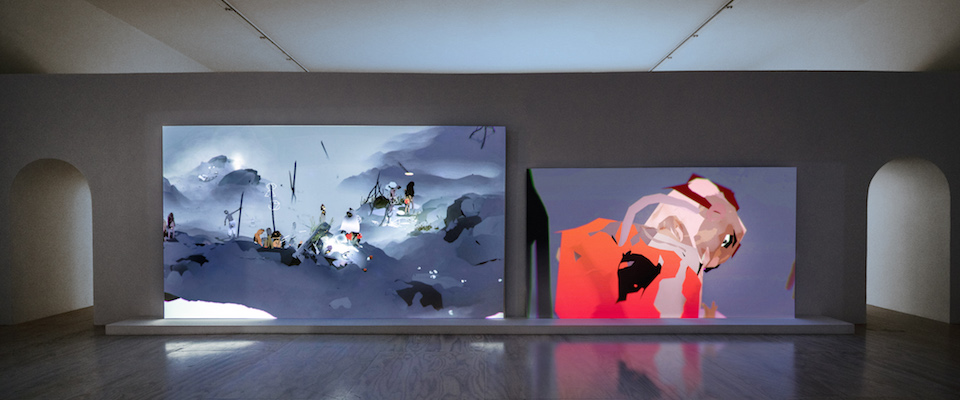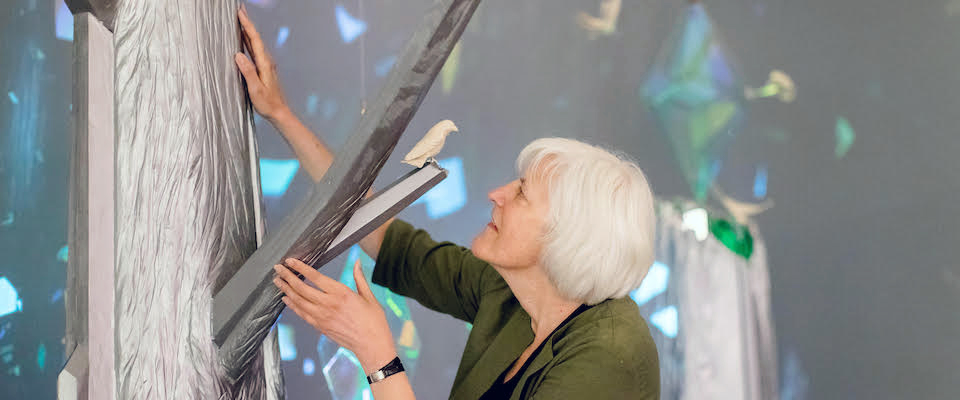How to describe artist Ian Cheng’s current exhibit at MoMA PS 1, a Brooklyn-based branch of the world-famous Museum of Modern Art in New York City? Imagine a projection on the wall, as wide as a tractor trailer, depicting chaos … with a story.
The title of this real-time simulation is Emissary Sunsets the Self, the third of three pieces being exhibited on the third floor of this former school. Each piece depicts an epoch in the life of a civilization: an ancient community faced with destruction; an artificial intelligence examining the fall of human life; an atoll that somehow develops sentience. Each larger-than-life piece develops in real time from a computer program Cheng has written.
In Cheng’s simulated universe, every character has its prescribed behaviors—trees sway, rocks roll, dogs walk around, a human keeps a fire stoked. As the characters interact with each other, the program moves in directions that not even Cheng can predict.
“So long as you have electricity plugged in, this piece will continue to run and mutate and change over time.”
It’s a story that begins at the flick of a switch: a digital big bang. From there, over the months of its residency at PS 1, the story unfolds, albeit a noisy and rather cacophonic one (a noisy, creaking, chattering soundtrack is also part of the exhibit).
“It never repeats itself,” said Cheng of his work. “So long as you have electricity plugged in, this piece will continue to run and mutate and change over time.”
Viewers are invited to sit in and watch, and many do; it is uniquely captivating, though impossible to follow. You can also view it online, until the exhibit concludes at the end of September.
Cheng, 33, has built a unique career developing digital worlds like these. Thought they appear at first glance to be some sort of cartoon, Cheng does not consider himself an animator.
“I make simulations, like video games that play themselves,” he said. “A by-product of that is that it is impossible to animate every creature, plant, or character in the simulation. Instead I have to develop algorithms that themselves can determine how the characters move in the simulation depending on the circumstance.”

A native of the San Fernando Valley outside Los Angeles, Cheng came to Berkeley in 2002 to double-major in art practice and cognitive science. Looking back, he says he felt challenged and stimulated by cognitive science, but it was art where he felt most at home. He counts three Berkeley professors among his early mentors—painter Katherine Sherwood, photographer Greg Niemeyer and performance artist Anne Walsh.
After Berkeley, Cheng spent a year in a coveted position, working for George Lucas’s Industrial Lights & Magic special effects and animation studio. “It was a dream to work there, especially to see the spectrum of art and engineering blur into one activity,” he recalled. But, he added, “I got scared that I’d never have a crack at authorship within such a large-scale structure.”
So he moved to New York City, pursued an MFA and began producing his own unique work. His first simulations were relatively simple, consisting of virtual objects left to influence and modify one another indefinitely. Entropy Wrangler, which appeared in PS 1 in 2013, was his first attempt to create an animated storyline with no end. As his work progressed and became more recognized, it also increased in complexity.
“It’s really a new art form. I think it’s not overstating the matter.”
“It’s a program, and every item has a unique behavior attached to it,” he explained to an audience in 2015. “When you combine two behaviors of different objects together, it’s kind of like putting a pit bull in the same room as a shark. Something is bound to happen.”
Over the past few years, Cheng’s work has been exhibited in museums and art shows throughout Europe, as well as New York City. His current exhibit at PS 1 marks his first solo show, said MoMA curatorial associate Jocelyn Miller.
“It’s really a new art form,” she said. “I think it’s not overstating the matter. It’s really remarkable to see this format, and to know that Ian himself is extremely enthusiastic about narrative. Every character in this thing starts with a little doodle in his notebook, and over time becomes this resolved digital character with its own name and story.”
Where does a young creator of worlds go from here? Cheng says he’ll continue building on his knowledge of simulations, with a special interest in developing the artificial intelligence of his virtual characters to make them more and more complex.
“I see this as analogous to the basic truth that there are multiple people inside us who get the spotlight depending on our emotional state and situation (hangry you, reasonable you, self-preserving you, ego-less you, etc.),” he said. “I have not strayed so far from my studies at Berkeley.”





















